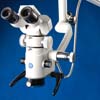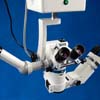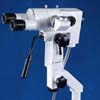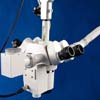ART.III.-Atrophic Choroiditis
The process which is the cause of this disease produces on one hand atrophy of the choroid, and on the other a softening or thinning of the sclerotic. Hence arises a disturbance of the of the equilibrium between the intraocular pressure and the resistance of the fibrous envelope, which yields and becomes ectasic, forming one or several staphylomata varying in position.1. SCLEROTICO-CHOROIDITIS ANTERIOR.
(Anterior Staphyloma.)
The intensity of the symptoms varies with the degree of acuteness with which the disease sets in. we find a general pericorneal injection, which surrounds the cornea with a rose-colored zone. This injection is, as a rule, more marked in a limited portion of the circumference, where it extends more towards the equator of the ball; this portion is raised slightly above the level of the surrounding tissue. At the same time, the iris changes its color and dilates slowly and irregularly, so that the pupil is slightly dilated, more markedly so near the most intensely injected portion of the cornea margin. In the position of this irregularity of the pupil, we see hyperemia of the vessels of the iris and sometimes adhesions of the papillary margin to the capsule of the lens; the aqueous humor becomes muddy, the anterior chamber is deeper, and the tension of the eye seems to be increased. Not unfrequently we find opacity of the cornea in the inflamed region.
After some time the curvature of the sclerotic round the cornea becomes modified, and curvature of the sclerotic begin to extend.
The swelling or swellings, for there are often several at the same time, are most frequently situated at some distance from the margin of the cornea, at the spot where the anterior ciliary arteries perforate the sclerotic. This is the thinnest portion, and its resistance is diminished by the great number of canals which give passage to the vessels, and which, during the inflammatory period, are still further dilated. At a more advance stage of the disease, the swelling takes the appearance of a salty-bluish projection, due to the choroidal pigment showing through thin and soften sclerotic. The inflammatory symptoms then disappear, the white of the eye is traversed in all directions with varicose veins, and we have now to deal with an anterior sclerotico-choroidal staphyloma.
The pain, scarely felt when the disease runs a slow course, may be very intense when it is rapidly developed. In addition to these ciliary pains, the disease portion is painful to the touch.
Any disturbance in the visual function is due to alternation in the aqueous and vitreous humors, a common occurrence in this disease, to symptoms of progressive myopia (caused by elongation of the antero-posterior axis of the eye), or to the apparition of flashes of lighty or sparks (due to the compression of the optic nerve).
As the staphylomata increase in size and number, vision decreases, and is ultimately destroyed.
Anterior staphylomata present, according to their form and position, numerous varieties. Thus, they are found at the equator of the eyeball, or near the margin of the cornea, in the free space between the insertions of the recti muscles, or again at the circumference of the insertion of the iris. In this position there may be several of these ectasias, which become united into a single projection encircling the circumference of the cornea. This form of annular staphyloma may also be produce when the sclerotic has been thinned all around by the intraocular pressure, and distends circularly,. Inconsequence of the general distention, the suspensory ligament of the lens (the zonule of Zinn) may be ruptured, and the lens itself dislocated; or, again, the iris, being attached to the lens in some cases by adhesions, may be torn from its ciliary insertion. As to the staphyloma itself, its wall is formed by the modified sclerotic, which is very thin and so distended that is fibres are separated from each other by small spaces. In these spaces we find deposits of choroidal pigment. The choroid is completely atrophied, so that there remains only a very thin pellucid membrane, which is closely adherent to the sclerotic. As to the retina, it may be in one of several conditions: sometimes it is atrophied and adherent to the base of the staphyloma, sometimes it forms a bridge at its base, or floats in its cavity. This cavity is filled with which resembles fluid aqueous humor. Again, the entire vitreous humor is often temporarily muddy or fluid in its anterior part.
In the neighborhood of the staphyloma, the sclerotic shows sign of serous infiltration, the choroid signs of atrophy (irregularities of the pigment).
The vessels and nerves participate in the alternations of the disease parts, and in the position of the ectasia are completely atrophied. This is the reason why, in the parts corresponding to the staphyloma, the cornea loses its sensibility and the iris its mobility.
Progress and Trmination.-Sclerotico-choroiditis anterior is seldom acute; more frequently it is so insidious that the attention is only aroused by the formation of an ectasia. Whenever this is formed the inflammatory symptoms disappear almost entirely, and the disease seems to be at an end.
It may indeed stop at this point, but more frequently there is before long a fresh inflammatory attack with the formation of a second staphyloma, or the enlargement of the first.
After a certain number of exacerbations, the disease may end in complete atrophy of the choroid, the eyeball preserving its distended form or becoming atrophied. We have also seen rupture of an isolated staphyloma (from injury, or spontaneously from excess of intraocular pressure), accompanied with the escape of the contents of the ball, and deep hemorrhage followed by suppuration and atrophy.
Prognosis.- the prognosis is serious, for the disease is never cured entirely; we can only hope to arrest itsprogress if we meet it at its outset.
Not seldom it produces partial loss of vision and deformity to the eyeball.
Etiology.-Although there seems to be no doubt that anterior ectasia of sclerotic is, in almost every case, due to sclerotico-choroiditis-i.e., to an inflammatory and an atrophic affection of the choroid, accompanied with softening of the sclerotic, there is great uncertainty as to the causes of this inflammation.
In young persons, in whom it most frequently occurs, it has been attributed to a lymphatic or scrofulous diathesis; in older people the sclerotic offers a greater resistance to the intraocular pressure.
Treatment.-In the early stages of sclerotico-choroiditis anterior, our treatment should be actively antiphlogistic; we should use the artificial leech, and, if the disease is very acute, we should give small doses of calomel, and mercurial frictions. In cases in which we have performed peritomy, we have seen this operation exercise a favorable influence on the course of the disease.
At a later period peritomy is still beneficial in removing opacities of the cornea. If the affection has become chronic, we may give small doses of the sublimate, and administer remedies which increase more especially the functions of the skin, intenstines or kidneys, according to the special indications of each case. If there be symptoms of serous iritis, or if the tension of the eye be increased, we must instill pilocarpine, or, in cases where there is posterior synechia, atropine; repeatedly performing paracentesis of the anterior chamber, and even iridectomy, by which we sometimes prevent or delay the formation of staphyloma.
Our general treatment must be suited to the state of the patient’s health.
If staphyloma has once developed, it can only be removed by an operation. Small ectasias of recent origin sometimes yield to iridectomy, or to the prolonged use of a compress and bandage combined with repeated paracentesis of the anterior chamber.
Well-developed staphylomata have been operated on by simple incision with consecutive pressure, or by partial excision, or again by total removal. But these operations are not without danger, because they are often fallowed by severe hemorrhage and suppuration. An attempt has been made to obviate such accidents by the preliminary hemorrhage, whenever the eyeball presents any considerable degree of hardness.
With the view of ridding the patient of the deformity, and of enabling him to wear an artificial eye, shrinking thread (von Graefe).
Again, when circumstances in the general condition of the patient of in the eye make it desirable to put a speedy termination to the disease, it is better at once to enucleate the eye by Bonnet’s method.
2. SCLEROTICO-CHOROROIDITIS POSTERIOR
(Posterior Staphyloma.)
This disease, which is very common in myopic eyes, is easily diagnosed from its very beginning by the ophthalmoscope. We find choroidal atrophy, which is recognized by the existence of a whitish patch of crescentic form, with its concavity resting on the margin of the optic nerve (Fig. 80).
If we see the disease at its very beginning, we find, on ophthalmoscopic examination that the choroidal pigment in the neighborhood of the optic nerve has begun to disappear; in this situation the fundus are larger than those of the retina, and are surrounded by grayish patches. The patches grow whiter, the vessels disappear, and the white cresen, characteristic of choroidal atrophy, is formed; the whiteness is due to the direct reflection of light by the denuded sclerotic.
The retinal vessels pass freely above the spots.
When the atrophic process has stopped, the external margin of the white patched is bounded by a very regular curve which separates it from the normal tissue (circumscribed atrophy). On the other hand, when the disease is progressing and involving the surrounding structures, we find an irregularity of the pigmentation preceding structures, we find an irregularity of the pigmentation preceding the atrophy, and by slow degrees the patch extended. Its contour is irregular, and often in a large patch we find several concentric circles, bounded by streaks of pigment, each of which marks what has at some past period been the external limit of atrophy.
The atrophic cresent is most frequently situated to the outer side of the optic nerve, sometimes below it and more arely above it, but it has been known to extend in all three directions, in treoil form, and cases have been seen in which it surrounded the optic papilla like a ring.
When the staphyloma has attained a certain degree of development, the optic papilla is no longer fairly opposite the observer. It seems to be oval and narrower when the atrophy extends laterally, broader when it extends above or below. At this point where it touches the ectasia, the papilla is sometimes cupped, especially if there previously existed a more or less deep physiological depression. Apart from these is progressive.
Atropy of the choroid and ectasia is not always confined to the immediate neighborhood of the optic nerve; we also see it, with the characteristics already described, in other parts of the fundus-eg., in the neighborhood of the macula, where it extendeds towads the papilla. Very rarely, we see, in the nieghboorhood of the staphyloma of the macula, reddish spots in the choroid, which indicate hemorrhagic effusions in that membrane.
Besides the symptoms furnished by the ophthalmocope, which indeed are the most characteristic, the presence of a stapyloma is also indicated by the following sign:
- The eye becomes myopic, or if myopic, the myopic increases during the Progressive period of the disease. this change is due to the elongation of the antero-posterior axis of the eye by the formation of the sclerotic ectasia (consult the chapter on myopia).
- The eyeball becomes ovoid in shape, as may often be seen on simple inspection; it protrudes, and on making the patient turn his eye inward, we see that the sclerotic has lost its normal curvature towards the equator, and that the conjanctival fold has become effected; in well-marked cases we can distinguish, near the posterior pole, the bluish prominence of that past of the sclerotic which forms the staphyloma.
- The eyeball loses its mobility, in consequence of the posterior ectasia coming in contact with the walls of the orbit in lateral movements of the eye. Again, since myopic person can only se distinctly near at hand, they must make strong efforts of convergence, and the internal recti muscle are therefore kept in an almost constant state of contraction. These muscle thus lose thire extensibility, and therefore prevent the eye from turning outwards to a normal extent.
In other is a great increase in the amount of myopia, the converging power of the internal recti does not increase correspondingly in the same length of time; there is thus an insufficiency of these muscles, which become incapable of maintaining the requisite convergence of the eye, and a divergent strabismus may be the result ( see chapter on Divergent Strabismus).
As to the anatomical characteristics of posterior staphyloma, they are perfectly similar to those described under anterior staphyloma.
Subjective Symptoms.-In the first place, the patients are annoyed by the progressive development of the myopia; this feature is specially notice if their refraction was previously normal, or, as more rarely happens, hypermetropic. Later, they complain of fatique following any prolonged use of the eyes, of dazzling, and of muscae volitantes. More rarely they complain of true photopsia, which is due to the dragging of the retina. Again, as the eyeball elongates, the retina is put on the strech, and its functions are altered, so there is a diminution of the visual acuteness. This is more markedly the case I the alternations are in the neighborhood of the mucula, for we then have a central scotoma, and the patients see better to the side that in front.
Any other disturbance of vision depends on the opacities of the vitreous body which frequently occur in this disease. indeed, it is rare that we do not find with the ophthalmoscope secondary alternations of the vintreous body, in the course of a sclerotico-choroidis, either in the form of isolated opacities, more or less mobile according to the degree of fluidity of the humor, or, less frequently, as a diffuse haze, in which we can, however, distinguish membraneous sherds. The shadows of these opacities project on the retina, often appear to the patient like cobwebs, flies, or dark spots of various forms.
Even where there is no loss of transparency, the vitreous almost always loses its consistence. This liquefaction in many cases is confined to the posterior portion, but it may general.
In more advance stage of the disease the lens presents opaque, isolated striae, or circumscribed opacities at its posterior pole, which opacities may remain stationary, or may involve the whole lens.
Exception made of the macula and its neighborhood, the appearance of the retina is not changed either at the seat of staphyloma, we find the functional disturbances which have been already mentions.
The defects in the visual field, which careful examination discovers, depend on enlargement of the blind spot.* on the alternations of the macula, which produce central scotoma, or on some other complication of the disease, such as separation of the retina or glaucoma.
Glaucoma in such cases is due to the greater resistance of the sclerotic, which becomes more rigid with advancing years. It then the intraocular pressure increase, the optic nerve affords at least resistance, and the pressure acting on it causes glaucomatous excavation (consult the chapter on Glaucoma). Amongst the other symptoms we find retraction more or less rapid of the field of vision.
The separation of the retina, to which the distention of the ball (yielded to less by the retina than by the other membranes) has rendered the patient liable, is due to an effusion of serum or of blood on the internal surface of the choroid. This complication of sclerotico-choroiditis posterior isone of the most disastrous, for it in great part destroys the visual functions of the eye, and it may supervene on both sides, if the other eye is similarly affected with progressive sclerotico-choroiditis.
Progress and Termination.-Sclerotico-choroiditis posterior, without showing any well-marked inflammatory symptoms, often follows a progressive course. The patient recognizes this by the increase of the myopia, and the surgeon by the opthalmoscopic symptoms already indicated. It may, however, come to a standstill, after a period of development, and remain stationary. In other cases, after a longer or shorter period of quiesnce, the process may begin again, and may be renewed from time to time. With each fresh attack, the ectasia of the sclerotic, themyopia, and the functional disturbance increase. In fine, by the complications which we have described, vision may entirely destroyed, the retina and optic nerve being atrophied. The same result may ensue from absolute glaucoma, or from separation of the retina, causing the formation of calcareous cataract, and gradual softening of the eyeball.
To repeat, we must distinguish three forms of this disease-(1) stationary, (2) periodically progressive, (3) continuously progressive.
Prognosis.- the prognosis is favorable when the disease is limited to the region of the optic nerve, and when it is of small extent and stationary. It is not bad if the progress of the disease be slow, and if the patient be in circumstances to follow the directions as to treatment indispensable if the disease is to be checked. The progress of the disease may be stopped at any stage by appropriate treatment. It is true that a high degree of myopia is always an aggravating circumstance which demands special attention. Moreover, central scotomas generally remain. The prognosis becomes very serious when a large part of fundus is involved in the disease, when the disease makes rapid progress, and especially when there already exist any of the more serious complication-e.g., separation of the retina.
Etiology.-The causes of this disease have not been completely elucidated. It is, howeve, beyond doubt that in the great majority of cases the predisposition is tobe hereditary, and is also the primary cause of the myopia.
This congenital predisposition consists in an arrest in the development of the sclerotic in the region of the optic nerve, where in the first period of fotal life this membrane presents a solution of continuity (sclerotic hiatus of Ammon). We must also remember that in this same region the sclerotic is pierced by a number of canals which give the passage to the ciliary vessels, and that it is not strengthened, as other portions of the membrane are, by the tendinous expansions of the muscles.
Again, to some extent the disease may be due to the antagonistic action of the oblique muscles on one hand, and of the internal recti muscle on the other a (Giraud-Teulon). This antagonism seems to promote the separation from each other of the two envelopes of the optic nerve, which by their union from the sclerotic.
Given these circumstances as considerably diminishing the resisting power of the sclerotic to internal pressure, and as therefore explaining the formation of a sclerotic ectasia in this situation, we must nevertheless have special causes for the development of the disease which we are discussing, for it is far from being developed in every case where this predisposition exist.
These causes must be sought in everything which promotes active or passive congestion of the eyes, for such congetions determine a hypersecretion of the internal fluids. In other words, an intraocular hypersecretion is the characteristic of sclerotico-choroiditis posterior, and on this account it may be classed with the hydrophthalmie. Although the anatomical changes observed in this disease are simplyatrophic, their origin is a serous inflammation with functional disturbance of the choroid. Amongst the causes of ocular congestion, we maymention prolonged efforts of accommodation, which in myopic persons are associated with a bent position of the head. And efforts of convergence, which are all the more hurtful inasmuch as the internal recti muscle do not always possess sufficient power to maintain the convergence.
In addition to these causes we have also general condition of the circulation.
This disease is most frequently met with in myopic persons and those whose occupations demand close attention on near objects, but we observe also isolated cases with country people where none of these causes exist. We can easily understand that the risk of development of the affection under consideration is much greater if the myopia is complicated with weak vision (from corneal or lenticular opacities), or if the person wears to strong concave glasses, and requires to counteract their effect by efforts of accommodation.
Treatment.-In the progressive period of the disease, characterized by increase of the myopia, irregularity in the choroidal pigment,neuralgic pains and subconjunctival injection, we must employ anti-phlogistic remedies. Repeated application of heurteloup’s leech in the evening, with restin a dark room for at least twenty-four hours, is often followed by an immediate improvement of the visual acuteness.
Along with this we order diuretics, mild cathartics or suborifics, according as one or other of the functions on which these remedies acts requires stimulation. We also give cold irrigations or douches to the eyes, and apply sinapisms to the limbs.
During the whole course of treatment the eye must be kept at perfect rest; and, in order that there maybe no effort of accommodation, it is well to used atropine for some weeks or months (Schiess).
If the alternations in the choroid are very extensive, we may advantageously administer small doses of the sublimate. When the disease has become stationary, we must warm the patient to be careful in the use of his eye every now and then, if only for a few moments. We must tell him to avoid insufficient light, as well as everything which may favor congestion of the head and eyes-e.g., cold extremities, constipation, clothing tight at the neck, excesses of the table etc.
The use of concave glasses should be in accordance with the directions which will be given in speaking of myopia, and dazzling sensation must be checked by blue or smoked glasses. The serious complications of the vitreous require the same treatment as the disease itself in its progressive form. Increase in the tension of the eye, especially if accompanied with glaucomatous excavation, should be stopped by iridectomy.
If there be senile cataract in an eye affected with sclerotico choroiditis posterior, we must make a careful examination to ascertain the presence of central scotoma, or of a detachment of the retina behind the cataract.
This last complication is all the more likely to exist if the cataract has been rapidly formed, if there are calcareous deposits, and if the patient has not attained the age at which senile cataracts generally form. If we are satisfied that there is no complication of this nature, we may extract the cataract.
Again, our attention should be directed to the condition of the internal recti, for muscular insufficient may contribute to the development of the disease, as it forces the patient to make special efforts.
In our chapter of muscular asthenopia we shall have to speak as to the methods fo detecting and correcting muscular insufficiency.
Back to Resources
call toll-free:  or email
or email

 or email
or email
Categories
Categories
Dental
Dental Microscopes
Dental Microscopes
Ophthalmic
Ophthalmic Microscopes
Ophthalmic Microscopes
Gynecology
Gynecology Colposcopes
Gynecology Colposcopes




